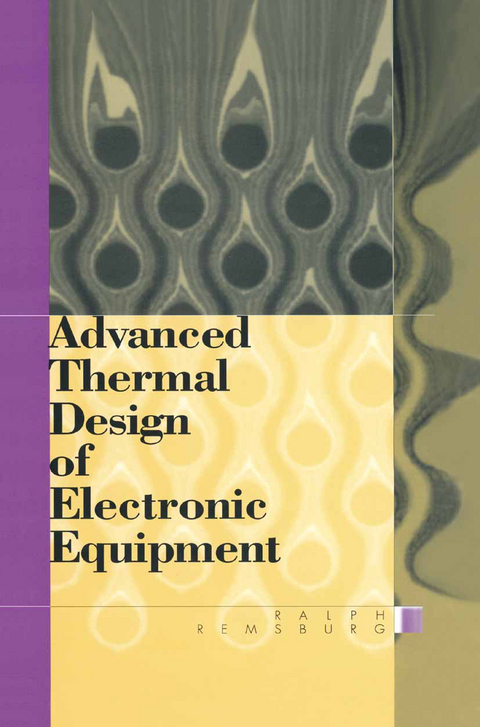
Advanced Thermal Design of Electronic Equipment
Seiten
2012
Springer-Verlag New York Inc.
978-1-4613-4633-3 (ISBN)
Springer-Verlag New York Inc.
978-1-4613-4633-3 (ISBN)
The field of electronic packaging continues to grow at an amazing rate. The emphasis for each project that the electronic packaging engineer faces changes from project to project, and from company to company, yet some constants should continue into the foreseeable future.
The field of electronic packaging continues to grow at an amazing rate. To be successful in this field requires analytical skills, a foundation in mechanical engineering, and access to the latest developments in the electronics field. The emphasis for each project that the electronic packaging engineer faces changes from project to project, and from company to company, yet some constants should continue into the foreseeable future. One of these is the emphasis on ther mal design. Although just a few years ago thermal analysis of electronic equipment was an afterthought, it is becoming one of the primary aspects of many packaging jobs. It seems that the days of just adding a bigger fan to reduce the overheat ing problem are almost over. Replacing that thought is the up-front commitment to CFD (Computational Fluid Dynamics) software code, FEA (Finite Element Analysis) software, and the realization that the problem will only get worse. As the electronic circuit size is reduced, speed is increased. As the power of these systems increases and the volume allowed diminishes, heat flux or density (heat per unit area, W/m 2 or Btulh ft2) has spiraled. Much of the improvement in the reliability and packaging density of electronic circuits can be traced to advances in thermal design. While air cooling is still used extensively, advanced heat transfer techniques using exotic synthetic liquids are becoming more prominent, allowing still smaller systems to be manufactured. The appli cation of advanced thermal management techniques requires a background in fluid dynamics.
The field of electronic packaging continues to grow at an amazing rate. To be successful in this field requires analytical skills, a foundation in mechanical engineering, and access to the latest developments in the electronics field. The emphasis for each project that the electronic packaging engineer faces changes from project to project, and from company to company, yet some constants should continue into the foreseeable future. One of these is the emphasis on ther mal design. Although just a few years ago thermal analysis of electronic equipment was an afterthought, it is becoming one of the primary aspects of many packaging jobs. It seems that the days of just adding a bigger fan to reduce the overheat ing problem are almost over. Replacing that thought is the up-front commitment to CFD (Computational Fluid Dynamics) software code, FEA (Finite Element Analysis) software, and the realization that the problem will only get worse. As the electronic circuit size is reduced, speed is increased. As the power of these systems increases and the volume allowed diminishes, heat flux or density (heat per unit area, W/m 2 or Btulh ft2) has spiraled. Much of the improvement in the reliability and packaging density of electronic circuits can be traced to advances in thermal design. While air cooling is still used extensively, advanced heat transfer techniques using exotic synthetic liquids are becoming more prominent, allowing still smaller systems to be manufactured. The appli cation of advanced thermal management techniques requires a background in fluid dynamics.
1 Introduction to Thermal Design of Electronic Equipment.- 2 Conduction Heat Transfer in Electronic Equipment.- 3 Fluid Dynamics for Electronic Equipment.- 4 Convection Heat Transfer in Electronic Equipment.- 5 Radiation Heat Transfer in Electronic Equipment.- 6 Heat Transfer With Phase Change.- 7 Combined Modes of Heat Transfer for Electronic Equipment.- 8 Acoustics for Electronic Equipment.- Appendix I A Brief History of Electronic Cooling Systems.- Appendix II Properties.- Author Index.- Author Biography.
| Zusatzinfo | XXXIII, 589 p. |
|---|---|
| Verlagsort | New York, NY |
| Sprache | englisch |
| Maße | 155 x 235 mm |
| Themenwelt | Informatik ► Theorie / Studium ► Algorithmen |
| Informatik ► Weitere Themen ► Hardware | |
| Technik ► Elektrotechnik / Energietechnik | |
| Technik ► Maschinenbau | |
| ISBN-10 | 1-4613-4633-9 / 1461346339 |
| ISBN-13 | 978-1-4613-4633-3 / 9781461346333 |
| Zustand | Neuware |
| Haben Sie eine Frage zum Produkt? |
Mehr entdecken
aus dem Bereich
aus dem Bereich
IT zum Anfassen für alle von 9 bis 99 – vom Navi bis Social Media
Buch | Softcover (2021)
Springer (Verlag)
CHF 41,95
Interlingua zur Gewährleistung semantischer Interoperabilität in der …
Buch | Softcover (2023)
Springer Fachmedien (Verlag)
CHF 46,15
Buch | Softcover (2024)
Lehmanns Media (Verlag)
CHF 55,95


